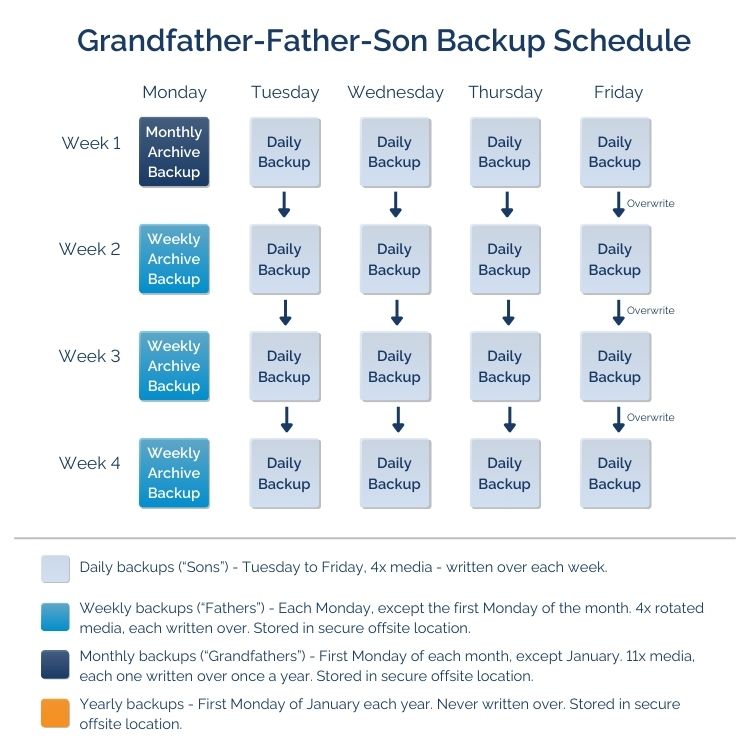Data archiving and retention plays a vital role in both business continuity and adherence to regulatory compliance guidelines in practically every industry worldwide. Protecting your business’s data privacy and cyber-resilience is essential, and you can achieve this with secure and recoverable backups. In this article, we will explore the grandfather-father-son backup scheme.
How Does the Grandfather-Father-Son Backup Scheme Work?
The grandfather-father-son backup scheme, also known as GFS backup rotation, is a simple and effective method for managing backups over time. It is especially useful for businesses with larger and complex data storage needs and is designed to balance the need for quick recovery with the requirement for long-term archiving.
GFS backup rotation works like this:
- Son (Daily Backup): The “son” represents the most recent backup, generally taken on a daily basis. This ensures that the latest version of your data is always available for recovery.
- Father (Weekly Backup): The “father” backup is taken less frequently, usually on a weekly basis. This version provides a historical perspective and allows you to recover data as it existed at the end of each week.
- Grandfather (Monthly Backup): The “grandfather” backup is the least frequent backup, and provides a long-term archive version of your data. It serves as a more extended historical backup, useful for compliance, auditing, or in case you need to recover data from a specific point in the past.
The rotation continues with the son becoming the father, the father becoming the grandfather, and a new son backup being created.
Below is an example of this concept:

What are the Benefits of the Grandfather-Father-Son Backup Scheme?
A business might choose to use the grandfather-father-son backup scheme for several reasons, including:
- Comprehensive Data Protection: The GFS scheme provides a well-rounded approach to data protection by maintaining multiple generations of backups. Recent backups (“sons”) ensure fast recovery, while historical backups (“fathers” and “grandfathers”) serve longer-term archival and compliance purposes.
- Fast Recovery of Recent Data: Since daily (son) backups capture the most recent changes, businesses can quickly recover the latest version of their data in case of accidental deletion, corruption, or other issues. This minimizes downtime and helps maintain business continuity.
- Historical Data Preservation: This is particularly useful for compliance, auditing, or recovering specific versions of data from the past.
- Regulatory Compliance: Many industries are subject to regulatory requirements that mandate data retention for a specific duration. The GFS scheme allows businesses to meet these standards by maintaining backups for different time intervals.
- Risk Mitigation: By having a multi-generational backup strategy, businesses reduce the risk of losing critical data due to unforeseen events such as hardware failures, ransomware attacks, or accidental data loss.
Conclusion
The grandfather-father-son backup scheme enables businesses to adopt a balanced and flexible approach to data protection. Combining the GFS backup scheme with the 3-2-1 backup strategy will ensure your business’s valuable data is protected.
BackupAssist Classic makes it easy to set up your GFS backup rotation with simple and easy-to-use tools. Download your 30-day free trial today!





